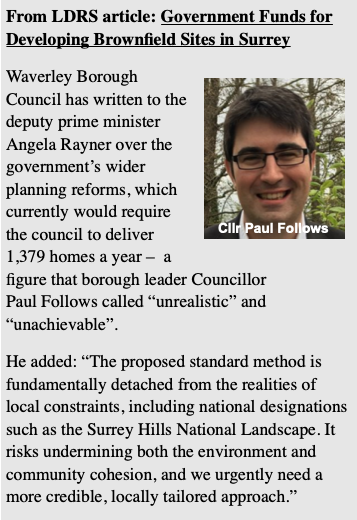 Abraham Lincoln
If given the truth, the people can be depended upon to meet any national crisis...
Abraham Lincoln
If given the truth, the people can be depended upon to meet any national crisis...
 Guildford news...
for Guildford people, brought to you by Guildford reporters - Guildford's own news service
Guildford news...
for Guildford people, brought to you by Guildford reporters - Guildford's own news service
Opinion: The Future is Congested, the Future is Grey
Published on: 20 Oct, 2024
Updated on: 21 Oct, 2024
Labour says it “put people and country first” with its housing policy.
But has it? Just which “people” do they mean?
Their 34 per cent general election popular vote, achieved only because of the overwhelming rejection of the bungling, discredited Tories, hardly allows them to speak for the whole country, nor all the people. But such niceties never worry politicians.
Those wishing to protect the green belt, and who are concerned about the over-development of our borough, simply have to, in the modern vernacular, “suck it up”.
 We thought things were bad enough with the 2019 Local Plan and its “black box” target of 562 new homes to be built each year. Just ask residents in Ash, Send and Horsley what they think.
We thought things were bad enough with the 2019 Local Plan and its “black box” target of 562 new homes to be built each year. Just ask residents in Ash, Send and Horsley what they think.
To be fair, Labour made no secret of its disdain for the green belt during the election campaign. The implication was clear: to care about it was selfish Nimbyism. Anyway, they said, some of it was not really “green” at all but “grey”. Who knew?
Confusingly, when asked to define the “grey belt” they described it as derelict petrol stations and the like, so the “grey” was what we had previously considered “brown”, as in “brownfield” sites which everyone had already agreed should be the first priority for redevelopment in any planning policy.
Faced with an apparently arbitrary doubling of the housing target to 1,102 per annum (while those in some London Labour areas have been held back) GBC planners have the unenviable job of trying to find all this grey belt to build on.
Of course, it does not exist, not in the quantities required to double the housing number, and the inevitable consequence, as the lead councillor for Planning at GBC tacitly admitted in her recent interview with me, is that more “strategic” (ie large) sites will need to be found and, given that the borough is still 85 per cent green belt, that means more real green belt will need to be sacrificed.
See also: Lead Planning Councillor on New Housing Target Proposal
Is anyone to blame? Well not if you are someone who welcomes the unprecedented increase in the UK’s population in the last 20 years or so and its all too predictable consequences.
But when was that policy ever put to the people instead of being swept under the carpet? Successive governments have known that a majority of us have been concerned by levels of immigration for years but they are always convinced that they know best – which is why everything is running so smoothly!
Some who dislike immigration are doubtless driven by xenophobia but more, I believe, are simply concerned about the pressure that a hugely increased population has in an already crowded country. Surrey has a population density of 724 people per square kilometre – the most densely populated county outside London. As a comparison, the Netherlands, Europe’s most densely populated country, has a density of 541.
New development has already damaged parts of our borough and more development will cause more yet harm to its character and our environment. Even if that were not the case, experience shows that promises of commensurate levels of new infrastructure are hollow. We’ve heard them all before.
Local Planning Authorities (LPAs) no longer have real power. Unfairly blamed by successive governments for daring to represent local concerns they have been stripped of the ability to do so, if they want to that is. Planning policy is now so centrally controlled that councils have little say. They don’t set their housing target and they cannot dictate to developers what is built or when.
But they are still blamed. Guildford was actually ahead of its housing delivery targets at the time of the general election but the Labour government cared not a jot.

Click here to link to article.
Nor can LPAs deliver the necessary infrastructure. They have neither the power, money nor expertise to do so.
It’s a complete cock up but one which many, if not most, are still unaware. I am told that railway passengers emerging at Guildford Station, looking at the towering and less than half complete development (unanimously refused by GBC but allowed on appeal), have been asking: “Who allowed this to happen?”
Doubtless some will be shocked by the high-rise new developments soon to be built in the town centre. It is a consequence of the all too casual indifference we have to local politics in this country.
I wish I could end with some crumbs of comfort but I can’t. There seems to be a consensus amongst the major parties that we can build our way out of the housing problem by only looking at the supply side. There appears to be no prospect of any serious desire to slow population growth by restricting its source, immigration. It’s like finding one’s bath overflowing and frantically mopping the floor without turning off the taps.
Not that we should stop all immigration, of course not. It is like food: too much or too little has damaging consequences. But we need much better control so that any population increase can be properly catered for and planned. Of course, that would require a real understanding of migration and planning issues, something that has been sadly absent from government since at least the 1990s.
Surely it is clear, even to the most obdurate, that the current level of net migration, around 700,000 in each of the last two years reported, is unsustainable
But unless there is an unlikely major change of heart at Government level, as asked for by the Lib Dem leader of Waverley Borough Council, who called the proposed new target for Waverley “unrealistic” and “unachievable”, expect a lot more building in the next decade, more green belt conceded, more local pressure on NHS services, schools, water supply and sewers and more congestion on our roads.
At least you, as one of the minority that bothers to keep up with local news, won’t be shocked when it happens.
Responses to Opinion: The Future is Congested, the Future is Grey
Leave a Comment Cancel reply
Please see our comments policy. All comments are moderated and may take time to appear. Full names, or at least initial and surname, must be given.Recent Articles
- Letter: Zero Carbon – Nothing But Hot Exhaust
- Following Slaughter of Cow, Police Warn Public Not to Buy Unpackaged Meat
- New Signage at Nature Reserve Unveiled
- Flashback: Mansbridge Survives Unprecedented Challenge To His Council Leadership
- Brutal Thieves Slaughter Animal for Its Meat Which Could Cause Sickness If Eaten
- Highways Bulletin May 19 – Protecting Wildlife During Roadworks
- Letter: It Would Be Good to Have Wind Turbines on the North and South Downs
- Letter: CIL Victims Deserve an Apology and Their Money Back
- 30 Objections Received on South Guildford Garden Infill Proposal
- Ash Residents Come Together To Counter Catapult Attacks On Canal Wildlife


Recent Comments
- Tony Draycott on Letter: House of Fraser’s Closure Was the Last Straw
- Maria Dobson on Angry CIL ‘Debtors’ Thanked for Their Patience by Waverley Council
- R Wong on Angry CIL ‘Debtors’ Thanked for Their Patience by Waverley Council
- Paul Robinson on Ash Residents Come Together To Counter Catapult Attacks On Canal Wildlife
- J Crawford on Angry CIL ‘Debtors’ Thanked for Their Patience by Waverley Council
- Brian Quinn on Angry CIL ‘Debtors’ Thanked for Their Patience by Waverley Council
Search in Site
Media Gallery
Dragon Interview: Local Artist Leaves Her Mark At One of England’s Most Historic Buildings
January 21, 2023 / No Comment / Read MoreDragon Interview: Lib Dem Planning Chair: ‘Current Policy Doesn’t Work for Local People’
January 19, 2023 / No Comment / Read MoreA3 Tunnel in Guildford ‘Necessary’ for New Homes, Says Guildford’s MP
January 10, 2023 / No Comment / Read More‘Madness’ for London Road Scheme to Go Ahead Against ‘Huge Opposition’, Says SCC Leader
January 6, 2023 / No Comment / Read MoreCouncillor’s Son Starts Campaign for More Consultation on North Street Plan
December 30, 2022 / No Comment / Read MoreCounty Council Climbs Down Over London Road Works – Further ‘Engagement’ Period Announced
December 14, 2022 / No Comment / Read MoreDragon Interview: GBC Reaction to the Government’s Expected Decision to Relax Housing Targets
December 7, 2022 / No Comment / Read MoreHow Can Our Town Centre Businesses Recover? Watch the Shop Front Debate
May 18, 2020 / No Comment / Read More











Ben Paton
October 20, 2024 at 9:05 pm
Is our MP doing anything about this?
Rob Mitchell
October 21, 2024 at 2:01 pm
It’s not valid to compare the population density of Surrey to the Netherlands. Maybe a better comparison is the province of Utrecht (central location, close to capital, similar population, mix of urban and rural) which has population density of 935 people per sq km – 26 per cent higher than Surrey. It’s also 16 per cent richer based on GDP per capita.
Roland Dunster
October 22, 2024 at 1:32 am
An excellent piece by Martin Giles, absolutely spot on. Tragically however, this government is equally determined to devastate our landscapes and nature with onshore wind and solar “farms”. All whilst choosing to ignore that mass rollout of solar on existing rooftops and car parks would generate energy equivalent to 10 power stations.
I wonder how many of those who, directly, or indirectly, afforded power to this administration are already regretting their decision, or soon will be…
T Saunders
October 22, 2024 at 10:50 am
I know there was a rally against the idea of digital ID cards suggested by Tony Blair, but this increasingly seems like a reasonable solution to problems we face. This would surely alleviate the burden on public services by having more control over who has access to them, rather than the free for all it seems to be now. It would give Government a better idea of legitimate numbers and therefore the ability to plan more effectively.
I don’t know what digital information could be of privacy concern over and above what information is already provided to entities like banks, the DVLA etc. It’s not without risk, but would expect the highest level of security around data protections and safety nets for where things could go awry.
Ultimately, I think this approach would increase the freedoms of British citizens rather than take them away, which may concern some. The Government are already part of our lives whether we like it or not (birth, marriage certificates, census records), so the direction of travel seems inevitable, it’s just a case of when a critical mass is reached in the public mood. We may be waiting a while!
Harry Eve
October 22, 2024 at 4:54 pm
If the biodiversity crisis had been recognised when the green belts were created then the contribution they can make to wildlife corridors and the retention of biodiversity would surely have been one of the guiding principles.
If you think about the M25 moving traffic around London then the Metropolitan Green Belt performs a similar function for wildlife.
Let us hope that, with COP16 now underway, our Government and local authorities recognise that retention of our green belt is crucial to nature recovery and restoration.